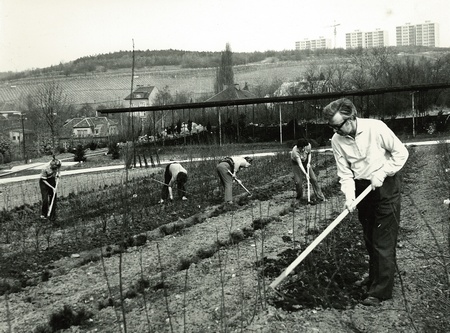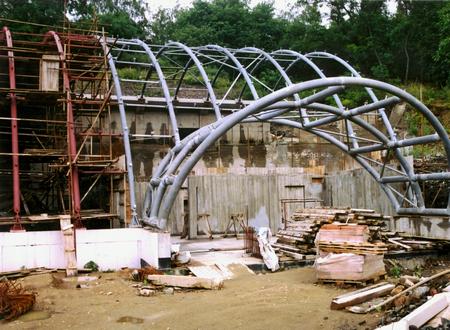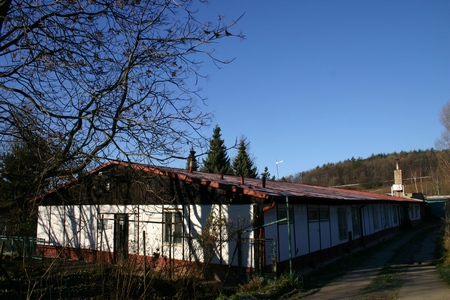The Prague Botanical Garden was established by a plenary resolution of the Prague National Committee (PNC) in 1968. It officially came into existence on 1 January 1969.
The establishment of a state-owned botanical garden was first proposed in 1958 by Ing. Jan Jager, who later became its first director. He suggested several suitable locations for the garden: the Průhonice Park, the upper part of the Šárka Valley, and the area between the Motol Stream and the Cibulka Estate in Košíře.
Troja was first suggested in March 1965 by the Office of the Chief Architect. They submitted a development plan of the Troja Basin for amendment procedure. Among other things, it included a proposal for establishing a smaller botanical garden in the area of today’s Havránka Natural Monument. The project also included the relocation of the Faculty of Science of the Charles University to Troja. The new botanical garden was to be an integral part of the new university campus.
However since the area around Havránka was too small, the Department of Agriculture of the PNC suggested moving the botanical garden north of the Prague Zoo into an area between the Podhoří and Velká skála reserves. The Office of the Chief Architect accepted these amendments in March 1966 and the PNC then issued a resolution accepting this decision. They ordered to draw up an explanatory report to establish the botanical garden in Troja.
1) Beginning of the 1970s

2) 2001: Construction of the Fata Morgana Greenhouse

3) The old house was pulled down in 2008

Resolution no. 111, dated 30 April 1968, approved the establishment of the Prague Botanical Garden in the Troja—Podhoří area. The garden was founded as an independent budget organization within the PNC on 1 January 1969.
Ing. Jan Jager, who significantly contributed to establishing this new botanical garden, was appointed its director (from 1 January 1969 to 31 December 1973). Together with the Association of Architects, he invited tenders for the layout of the botanical garden. This proposal, however, has never been fully implemented.
In 1973, Ing. Josef Vyskočil became the garden director and remained in this post until 1989. During his tenure, the area around the administration building in Nádvorní Street was gradually transformed into exposition areas. In Na Farkách Street, not far from the Bohnice housing estate, a large plant-growing garden was established in 1975. Another plant-growing area was established near K Pazderkám Street.
In 1982, areas Podhoří, Salabka, and Havránka, which lie within the grounds of the botanical garden, were declared protected areas. The entire botanical garden was designated as their protective zone.
In 1984, a new development study was prepared by the Prague Planning Institute under the leadership of chief engineer Ing. M. Železný. As part of the study, extensive surveys were carried out. The design and development plans of the garden were created, but the development plan has never been brought to life.
Although construction came to a standstill in this period, a rich assortment of plants was gathered in the garden: evergreen deciduous and coniferous woody plants, mini roses, the assortment of cultivated iris hybrids, and wild bulbous plants. We were also amongst the first in the country to establish a bonsai collection. Index Plantarum published in 1979 contained a total of 1889 species and cultivars. Our botanical garden also organized a number of events: iris exhibitions, holiday camps or competitions, and lectures for schools focused on natural sciences.
Despite all efforts, the botanical garden in Troja was not opened to the public until 1989. Due to a lack of finance and years-long discussions about the meaning and mission of the botanical garden, it has never been built in its originally planned size, which would make it one of the largest botanical gardens in the world. Until 1992, our garden has never been open to the public all year round. Visitors could only come during so-called Open Days. Therefore, it was completely unknown to most people in Prague.
After 1989, director Ing. Josef Vyskočil was removed from office, and Ing. Evžen Pechman became the director in his stead (until June 1993). One of the biggest problems he had to solve was property issues related to objects and lands in areas the garden was interested in. It was thanks to his efforts that the garden opened to the public after many years in August 1992. Its first exposition was called the Initial Exposition and it was a park-like area between the administration building in Nádvorní street and the St. Claire's Vineyard. This year marked a turning point in the existence of our botanical garden because it was finally brought to the notice of the people of Prague, for whom it was created.
In 1997, expositions were enlarged by more than 1.5 hectares. We also opened the Japanese Garden, the moorland along the vineyard wall, the exposition of flora from Turkey and the Mediterranean, and also our collection of irises.
Based on the design developed in 1995-1996, we began to prepare the construction of tropical greenhouses. The idea to build a large and attractive greenhouse was conceived by Jiří R. Haager, who was the director of the garden from February 1994 to November 2001. He based his decision on more than thirty years of experience with growing tropical plants and also on expeditions to the tropics of South America and Southeast Asia. His approach can best be summarised by the following quote: “I hate those square little glass houses with tables full of potted plants. I dream of a natural and intimate exposition with plants you can't find in other gardens. And a tropical rocky gorge is a wonderfully romantic place for dreaming.”
In the spring of 1995, we announced a competition for the best tropical greenhouse project. Its winner was architect Zdeněk Deyl. Based on his proposals, a zoning permit was issued in October 1997, and a building permit a year later. Unfortunately, the construction of the Fata Morgana Greenhouse took longer than expected (for various reasons). The finished greenhouse was approved in May 2003. Testing operations started in September of the same year in the presence of the Mayor of Prague, Pavel Bém. It was fully opened to the public in June 2004.
The finished cultivation facilities under the Fata Morgana Greenhouse were approved in the spring of 2008. Shortly, we hope to complete a proper entrance to the greenhouse including a small restaurant, information center, and flowerbeds appropriately linked to the greenhouse.
In 2002, a development plan for the botanical garden was approved. It was prepared by a team of authors led by Ing. Arch. Dandy. The garden will gradually develop based on this 10-year plan. Our goal is not only to offer visitors 17 hectares of exposition spaces including more greenhouses (greenhouses with bulbous plants and with carnivorous plants), but also to build a new administration building and move the main entrance to the northern part, which should alleviate the problematic transport situation in Troja.
In 1995, our botanical garden acquired St. Claire's Vineyard, which is classified as a national heritage. Between 1996-1997, we managed to repair a large part of the dilapidated vineyard wall. In May 2001, a viewpoint near St. Claire's Chapel was opened and in April 2004 we opened the upper part of this unique Prague vineyard together with the vineyard house. Since 2005, the vineyard has been open all year round.
In February 2005, we began redeveloping a part of the vineyard above Trojská Street, since there was a risk of landslides, and damage to the perimeter walls and the main access road to the Prague Zoo. In May 2009, we started to embed the Wine Production Exposition into the load-bearing structure of the redeveloped slope. The exposition was ceremonially opened in September 2009 and consists of three adjoining cellars. The middle room serves as the entrance area, the western room is intended for wine production and the eastern room is used as bottled wine storage. Here visitors can taste our wines. For the first time in the long history of our vineyard, local wine could be processed on-site.
2011 was a breakthrough year for our botanical garden. Before 1 April, we merged the fragmented outdoor expositions (called the South Grounds, the North Grounds, and the Freely Accessible Expositions) into one unit. Although this measure was not very popular with our neighbors, the visitors welcomed it. Since these exposition units were separated from each other by fences, visitors often got lost between them. Now, however, they can visit one large and well-arranged outdoor space with many interesting plants.
Since April 2011, the outdoor expositions have covered almost 25 hectares and are open all year round.
In addition to the popular Ornamental Garden (the oldest part of our outdoor expositions which was opened to the public in 1992) and the Japanese Garden (founded in 1997), we opened the following exposition units:
The Hillside with preserved fragments of original steppe communities, which were typical in Troja until the 1920s, when they were turned into intensely grazed pastures, arable fields, and orchards. We have also been gradually planting drought-loving woody plants with interesting flowers and fruits.
The Peony Meadow contains one of the largest collections of woody and wild peony species in the Czech Republic. It also includes a collection of magnolias, which is particularly spectacular at the turn of March and April, when dozens of these beautiful woody plants bloom.
Open to the public all year round is the fascinating exposition called Shade-loving Perennials and Evergreen Woody Plants (forest plants). It is a unique collection of plants that grow in the undergrowth of deciduous forests in Europe, Asia, and America.
A great draw for all lovers of cacti and succulents is undoubtedly our collection of cold-hardy cacti in the North American Semidesert exposition, which focuses primarily on North American representatives of the prickly pear and yucca. In addition to plants from the Cactaceae family, visitors can also see many North American perennials and conifers, which form the basis of these communities in the wild.
The Wetlands and Pond belong to the few places where frogs can lay their eggs in spring. In addition to interesting plants that live in water or marshes, visitors can also see carnivorous plants. During spring, they can observe the development of our local frogs and newts.
In the Forest Habitats of East Asia and the Forest Habitats of North America expositions we are gradually planting dozens of interesting woody plants. We are also adding more plants to the forest floor layer, so in a few years, these areas will create a perfect illusion of East Asian or North American forest communities.
We would also like to connect our outdoor exposition with the West Grounds by a bridge over a historical hollow way. This important milestone, however, is still ahead of us due to unresolved ownership issues related to the plots.